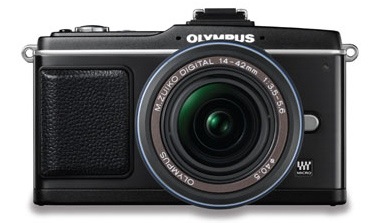By Steve Baczewski
On the heels of the E-P1, Olympus (http://www.olympusamerica.com) has released its latest Micro Four-Thirds camera, the Olympus PEN E-P2 (US$1,099.99). Like the E-P1, the E-P2 is an homage to their 1959 35mm film rangefinder Pen camera series.
The E-P2 uses the same 12.3-megapixel Live MOS sensor and 3-inch, 230,000-dot LCD as the E-P1. And, like the E-P1, it has no prism or mirror assembly, so light travels directly to the sensor. The result is a relatively light, compact camera that supports interchangeable lenses.
There are several new features, including two new art filters, anti-reflection coating on the LCD, and the ability to automatically lock focus and track your subject in both still and video. The key new improvement over the E-P1 is the addition of the accessory port under the hot shoe. The port supports a newly designed Electronic Viewfinder (EVF) that helps to make the E-P2 a pleasure to use. The high-res EVF is bright, sharp, covers 100% field of view, displays all the pertinent data, and is more practical for composing and viewing in bright outdoor light than the E-P1’s low-resolution LCD. The accessory port also supports an optional external microphone.
The metal body feels solid and is light enough to carry around all day. Visually, the relatively slim E-P2 looks similar to the E-P1 but now sports a black body with a raised leather grip that helps to give the camera a nice balance. Dust removal and image stabilization are built into the camera and work well. The controls are well placed and I especially like the accessible design of the mode dial at the top left and the thumb wheel on the top right for selecting settings of menu items.
A super control panel allows quick access to frequently used features. The EVF’s design lets it articulate to a 90º angle for waist-level shooting, and it has a large diopter ring that’s much more practical than the traditional minuscule adjustment wheel. My only criticism of the new EVF is that it’s too bright with no option to adjust the color level. Colors appear slightly washed out and there’s a discrepancy when compared to viewing your subject with the naked eye.
The E-P2 shoots continuously at 3 frames per second (fps) RAW and up to 9 frames before the buffer is full. Autofocus in daylight seems snappier on the E-P2 but remains slow in dim light and with low-contrast subjects, often necessitating switching to manual focus and using the 7x magnification feature. The E-P2 has an ISO range of 100–6400 with noise becoming a factor at ISO 800.
The autofocus system now can track a subject across the viewing area, whether you move or the subject moves. The tracking rectangle jerks occasionally with rapid subject movement but generally works well.
The E-P2 captures in RAW, JPEG, standard video, and 720p high-definition (HD) video. The manual video mode lets you control exposure, enabling you to adjust both the shutter and aperture. The video mode also lets you incorporate the zoom lens and any of the eight art filters. The image quality of both the RAW stills and HD video is good.
The two new art filters are Diorama (which makes your subjects look like miniature models) and Cross Process (imitating effects of various traditional films). The art filters can be effective if used judiciously, but overuse runs the risk of becoming gimmicky.
The camera’s exposure system is accurate and shooting in RAW resulted in accurate color rendition and a good dynamic range with plenty of shadow and highlight detail. The bottom line is that the E-P2 is solid, a pleasure to use, and worth looking into.
Rating: 8 out of 10
(This review is brought to you courtesy of “Layers Magazine”: http://layersmagazine.com/).



